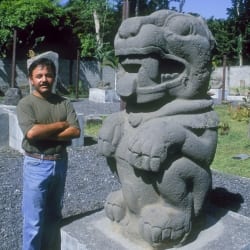Oswaldo Chinchilla

Oswaldo Chinchilla
Competition: Latin America & Caribbean
Universidad de San Carlos de Guatemala, Museo Popol Vuh
I graduated at the Universidad de San Carlos de Guatemala, with degrees in Archaeology and Biochemistry, both awarded in 1990. To pursue graduate training, I earned fellowships from the Wennerâ€Gren Foundation for Anthropological Research (1990â€1993), and Vanderbilt University, where I completed my Ph.D. in 1996. Subsequently, I developed my dissertation research topic into a longâ€term research program, focusing on the preâ€Columbian city of Cotzumalhuapa, in southern Guatemala. Despite its importance, this archaeological center had remained largely overlooked by archaeologists since the 1960’s. My work included systematic research on the settlement patterns and urbanism of this ancient city. Through my projects and publications, Cotzumalhuapa is now recognized as one of the major Classic cities of Mesoamerica, and a key to understand the social and cultural processes that shaped the development of preâ€Columbian societies.
I have devoted much attention to the Cotzumalhuapa sculptural corpus, numbering more than 200 monuments. Detailed recording of the carved surfaces has allowed me to produce new interpretations of the monuments’ iconography and inscriptions, while making them accessible to other scholars. While concentrating on Cotzumalhuapa, I have also contributed significantly to the interpretation of mythological representations in ancient Maya art, using innovative approaches that benefit from a broad perspective of Mesoamerican religion, art, and writing. My recent book, Imágenes de la Mitología Maya (2011) offers a novel approach to the study of ancient Maya religion and art.
Through the years, my work at Cotzumalhuapa has been supported by multiple institutions. For my dissertation research, I benefited from a National Science Foundation grant (1995), and a fellowship at Dumbarton Oaks (1995). A fellowship from the German Academic Exchange Office (DAAD, 1995) allowed me to record and study an important collection of Cotzumalhuapa sculptures, preserved since the nineteenth century at the Ethnographic Museum of Berlin, Germany. Further field research has been supported by six research grants from the National Geographic Society (1996, 1998, 2000, 2005, 2009, and 2010), three grants from the Foundation for the Advancement of Mesoamerican Studies (1997, 2000, 2002), and additional grants from the Wennerâ€Gren Foundation (2001), and the Panâ€American Institute of Geography and History (2006). The results of my research have been published in peerâ€reviewed journals and books in Guatemala, Mexico, England, Germany, and the United States. In recent years, I have been invited to present my work at various institutions, including the Universidad Nacional Autónoma de México, the University of Pennsylvania Museum of Archaeology and Anthropology, the Dumbarton Oaks Research Library and Collection, the Peabody Museum of Archaeology and Ethnology, Harvard University, and the Quai Branly Museum, Paris.
I am currently Professor in the Archaeology Department of the Universidad de San Carlos (1997â€2010) and Curator of the Museo Popol Vuh, Universidad Francisco Marroquín (1998â€2010), in Guatemala city. At the Museo Popol Vuh, I am in charge of an outstanding collection of ancient Maya art and archaeology. During my tenure as curator, the museum has become widely recognized as a leading institution in the conservation, public display, and interpretation of the ancient peoples of Guatemala. I have curated several exhibitions that bring attention to topics such as the history of chocolate in Guatemala (Kakaw: El chocolate en la cultura de Guatemala, 2005), and underwater archaeology (Arqueología subacuática: Amatitlán, Atitlán, 2011). Our educational program reaches thousands of schoolchildren, while our internet site is ranked among the first in terms of content and quality in Maya archaeology.
As a professor and museum curator, I am keenly aware of the importance of making the results of my research available, both to archaeology students and colleagues, and to the general public. My research projects provide ample opportunities for training to archaeology students, while allowing them to develop their own research interests. I am also concerned with raising awareness on the importance of preserving the archaeological remains of Cotzumalhuapa, as a potential resource for the economic development of the modern community, and a link to an important chapter in the history of Guatemala’s indigenous peoples.